TRAVELLING in CHRISTIE'S FOOTSTEPS: Appointment with Death
- David Morris
- Mar 26, 2023
- 7 min read
While one can collect tangible Agatha Christie items – such as books – it is sometimes the intangible experiences that can be an even more satisfying part of the ‘collecting Christie’ journey. One area I've focused on is collecting Christie-related travel experiences.
Throughout Christie’s works, real locations were integrated into the stories and in many cases became as vital as a character to the story. Without Burgh Island, the SS Karnak or the Orient Express train, the world of Christie would be far less rich.
Her novel (and play) Appointment with Death benefitted from locations in the Middle East – but most notably the Nabataean city of Petra. There are plenty of other references to locations in this novel, such as the Solomon hotel Jerusalem, the Dead Sea, Solomon’s stables, the wailing wall, the Mosque of Omar, Bethlehem, Nazareth, Tiberius, and the Sea of Galilee, but Petra is the dominant location.
For our journey in Christie’s footsteps we chose solely to visit Jordan. Here we could still get a feel for the region in Christie’s day and most importantly visit Petra. It should be noted that when Christie wrote the book in the mid to late 1930s, the region’s politics and borders were very different. Palestine and the broader Levant region were likely far easier to travel around. Today, Israel and the other countries of the Levant are not always the easiest of neighbours. With Jordan describing itself as a sea of calm in an often troubled region, it is appealing to many global travellers.
Jerash:
Early in the novel, we get a quote from Mr. Cope that teases at some of the sites Jordan has to offer. “Then there’s Jerash, there are some very interesting ruins there- Roman, you know. And I’d very much like to have a look at the Rose Red city of Petra, a most remarkable natural phenomenon, I believe that is – and right off the beaten track – but it takes the best part of a week to get there and back, and to do it properly.”
We decided that for our trip to Jordan we would seek to experience most of the key highlights the country had to offer. These included the Roman citadel and theatre in Amman, the fabulous Roman city of Jerash, various castles, including the desert castle of Azrak where T.E. Lawrence based his operations, various biblical sites including Bethany where John the Baptist worked, the Red Sea port city of Aqaba, the Dead Sea, the desert of Wadi Rum with its nomadic Bedouins, and of course Petra.
Mr. Cope was understanding the importance of Jerash when he said it had some very interesting ruins. Jerash should be a must-see destination for any visitor to Jordan.
It is one of the most completely preserved Roman cities anywhere. With its multiple temples, cobbled colonnaded streets, expansive forum, hippodrome and Hadrian’s Gate, it is a stunning location.
Petra:
Certainly Petra is the core location in Christie’s novel Appointment with Death, and rightly so.

Today it is recognized not only as a UNESCO World Heritage site but as one of the current seven wonders of the world.
Located on the outskirts of the town of Wadi Musa (the place of Moses’s spring), most visitors enter through the ‘siq’ – essentially a narrow, rock slit of an entrance carved out over the years by rains and floods. Today, the wash is diverted reducing, though not eliminating, the chance of the entrance closing during heavy rains. The walk through the siq also have sections of Roman paving underfoot as they paved it after they began trading with the Nabataeans and there are remnants of an arch built for Emperor Hadrian’s visit that is right at the entrance to the siq.
After a long winding walk, you see the end of the siq and the magnificent Treasury building appears, just as the artist Robin ‘Mac’ Macartney illustrated it on the spine of the Collins Crime Club first edition jacket. Of note, the building never was a Treasury, but is believed to have been the mausoleum of the Nabatean King Aretas IV in the 1st century AD. Only in recent years did the local Bedouins name it the Treasury on their belief that there were treasures to be found in there.
The city of Petra is approximately 300 square kilometres, so it is much more than just the Treasury building. Christie’s novel references ascending to the ‘Place of Sacrifice’ – the ‘High Place’, while the dust jacket artwork also shows the Nabataean theatre – which despite appearing Roman is not.
Other Insights:
The walk winding up the Monastary is also well worth it. That building is almost twice as large as the Treasury and with its hill top location is quite spectacular.
The 'Rose red' colour is also very visible inside many of the caves. Given that the caves play a prominent role in the novel, climbing up to visit some of them is essential. Also, the cover for the first Tom Adams paperback also was clearly inspired by some of these colours and formations.
At the entrance to Petra in Wadi Musa is an excellent museum about Petra and well worth a visit. Across the street is the Movenpick hotel that has wonderful architecture inside – especially in the bar and lounge, that evokes a golden era of travel. If you come in the cooler times of year, it can rain and Petra can be closed to visitors if the siq floods. Thus, consider booking at least two nights here to ensure access as multiple days of rain are very uncommon. Petra also offers a ‘Petra by Night’ experience. While we did buy the tickets, it cannot be recommended. While having luminaries lines the sides of the siq is attractive, the ‘show’ is of the utmost disappointment. Several thousand people are crammed on to very uncomfortable folding stools in front of the Treasury, where after an hours wait for the crowd to filter in, the entertainment is one man who plays a rebab (local guitar) for half an hour and another man who plays a shababa (local flute) for another half hour – and that’s it.
Collecting Books: The first edition of Appointment with Death was published on May 2nd, 1938.
Issued in a wonderful jacket, it evokes both the time and place of Christie’s visit. It is a highly appealing collectible for any fan of Christie’s works – but is also for those with deep pockets. A jacketed version in very good condition will generally cost at least £4-6,000.
The US first edition’s dust jacket (Dodd Mead & Co, 1938) sadly lacks any artwork and thus is unappealing visually. It is a lot more affordable than the Collins first with very good jacketed copies costing around $1,000 - $1,500 currently.
At the other end of the price spectrum would be paperbacks. The first paperback was published by The Albatross in Europe, though in English. Published in 1939 and numbered 444, this is a scarce and highly collectible book. Fair value for a jacketed paperback in very good condition is now likely £200 -£300. An unjacketed copy may still command up to £100.
Unlike the hardback version, the US market did provide an exceptionally appealing paperback book to collect – the Dell mapback #105 from 1946. Its wonderful rear panel helps bring to life the story with its informative map. A very good copy can be acquired for $10-$20 US.
The Collins Crime Club White Circle paperback was first issued in 1941 (#119c) and was the first UK paperback edition of the novel. It can generally be found for for only £15-20 in very good condition.
Tom Adams did two different jackets for Fontana. His later cover with the spider emerging from the lady’s head is quite disturbing, though his first iteration is more specific to the novel. Both can be found for around £5-10 in very good condition.

Most other paperbacks can easily be found in very good condition for only £5.
The Play:
Christie adapted this novel for the stage in 1945. Of note, it is one of the most reworked stage adaptations Christie did. Not only did she remove the character of Poirot, but she also removed another key character, changed the relationship of Ginerva, and most significantly changed the ending drastically. Without providing any spoilers, I will just say I strongly recommend reading the play. In my opinion, the ending is much more satisfactory than the novels. The first Samuel French printing of the play was in 1956 and numbered acting edition 990, priced 4s net. It is incredibly scarce for some reason. It is likely many collectors seek it and I would expect it to sell for in excess of £200 – a substantially higher price than most playscripts. For the casual reader, just order a new playscript from Samuel French off their website.
The Film Adaptations:
The film version of Appointment with Death (1988) features Peter Ustinov, Lauren Bachall, John Gielgud, Haylel Mills and Carrie Fisher. Sadly the film takes place only in Jerusalem and Qumran (near the Dead Sea). This change was made because the production company was based in Israel and thus wanted to avoid the complexities of entering Jordan. Unusually, the film has never been released on DVD for the North American market despite having a theatrical release in the States. American audiences will need to be creative to find a way to watch the film.
The David Suchet starring production in 2008 is sadly one of the worst Suchet ventures produced. The script was heavily changed, as was the location. Casting Tim Curry post-Rocky Horror in anything is always a risk too. The changes to the characters from the novel, the motive for the murder, and the backstories, all combined to provide one of the worst adaptations of the Suchet era.
Consequently, this novel still offers the potential for an authentic film production that does the book justice and is filmed in Petra. Given that Indiana Jones was able to film at Petra there is no reason a Christie film could not be shot on location. One can only hope.









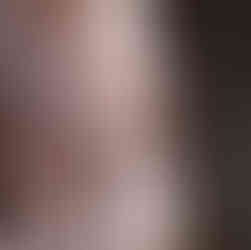






























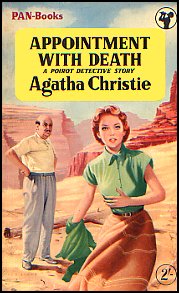







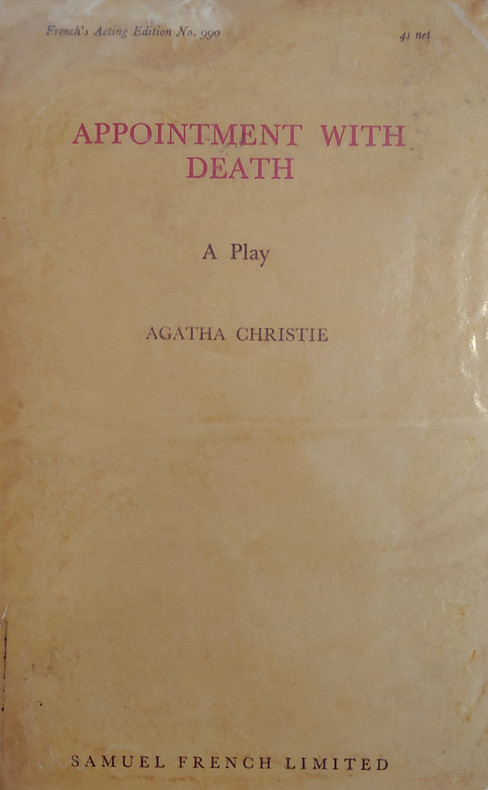



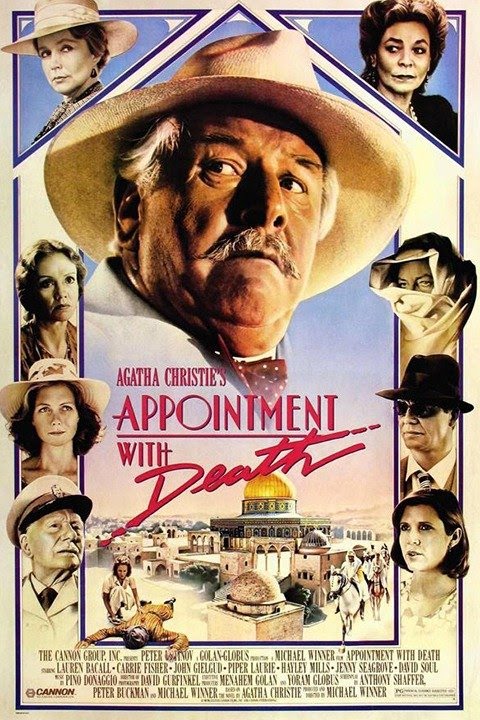

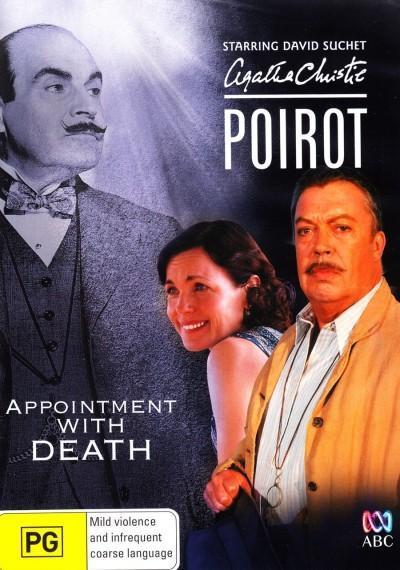
The Tom Adams "spider" cover is a personal favorite.